Plant of the Week
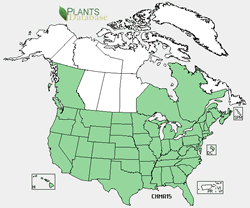 Range map of Chamaesyce maculata. States are colored green where the species may be found.
Range map of Chamaesyce maculata. States are colored green where the species may be found.
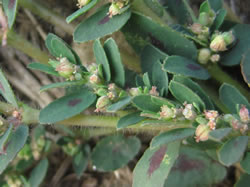 Fruit and petal-like glands. Photo © 2011 David D. Taylor.
Fruit and petal-like glands. Photo © 2011 David D. Taylor.
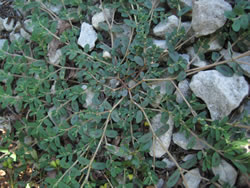 Small mat in gravel. Photo © 2011 David D. Taylor.
Small mat in gravel. Photo © 2011 David D. Taylor.
 Ant on glands of plant without leaf spots. Photo © 2011 David D. Taylor.
Ant on glands of plant without leaf spots. Photo © 2011 David D. Taylor.
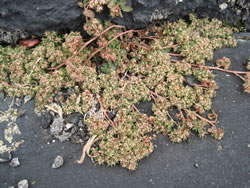 Dense leaves and branches on plant in asphalt parking lot; stamens can barely be made out as small yellow dots. Photo © 2011 David D. Taylor.
Dense leaves and branches on plant in asphalt parking lot; stamens can barely be made out as small yellow dots. Photo © 2011 David D. Taylor.
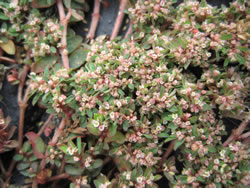 Dense leaves and branches on plant in asphalt parking lot; stamens can barely be made out as small yellow dots. Photo © 2011 David D. Taylor.
Dense leaves and branches on plant in asphalt parking lot; stamens can barely be made out as small yellow dots. Photo © 2011 David D. Taylor.
Spotted Sandmat (Chamaesyce maculata (L.) Small)
By David Taylor
Spotted sandmat is a member of the Euphorbiaceae (Spurge) family. Like most members of the family, it has a milky sap (latex). The sap of many spurge family plants is caustic or a skin/eye irritant. The sap of spotted sandmat is an irritant for many people although it has traditional medicinal uses. Many spurges use colorful bracts (modified leaves—think of the red 'petals' of a poinsettia) or flower appendages (glands) to attract pollinators and this species is no exception. Using a hand lens, one can find the white petal-like glands In spotted sandmat the glands are tissue arising from a structure (cyathium) that holds the flowers. The flowers and cyathia in this species are small.
This spurge generally hugs the ground forming mats to 4 decimeters (16 inches) or more across and is seldom over 1 centimeters (3/8 inches) high. The stem is slender and hairy with small opposite leaves 5-7 millimeters long and 2-3 millimeters wide (1/5 to 1/4 inches and 1/12 to 1/9 inches). The leaves often have a red spot on them; hence, the common name spotted sandmat, and the scientific name 'maculata' that means spotted. The plant is alternately branched, each branch with a leaf opposite it on the stem. Clusters of involucres are generally arranged alternately along the stems. Each cyathium holds one pistillate (female) flower and several staminate (male) flowers. The pistillate flower develops into a hairy, three-lobed capsule.
Spotted sandmat is an open land species, preferring drier, often exposed soils. As its common name indicates, it is often found in sandy soils. It is also at home in sidewalk cracks, gravel, roadsides, gardens, and other disturbed areas with limited competition. In especially harsh environments, leaves and branches are often dense. It is sometimes found in woodlands and savannas following severe fire that leaves mineral soil exposed. It is known from all states except Alaska (introduced to Hawai'i). It is known from, but considered introduced to British Columbia, Ontario, Quebec, New Brunswick, Prince Edwards Island, and Nova Scotia.
In many manuals and online sources, this species is called Euphorbia maculata. Many older manuals call an upright species with red-spotted leaves (Chamaesyce nutans) Euphorbia maculata in error.

